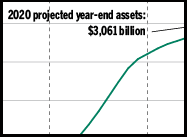CQ WEEKLY – IN FOCUS
May 19, 2012 – 11:12 a.m.
Social Security’s Planned Shortfall Raises Concerns
By David Harrison, CQ Staff
Immediately after the Social Security trustees released their annual report last month, concluding that the retirement and disability trust funds together are flush enough to pay all benefits scheduled until 2033, House Minority Leader
“Despite the repeated efforts of Republicans to privatize Social Security and end the Medicare guarantee, these vital initiatives remain strong,” the California Democrat said in a written statement.

|
||
|
Senate Finance Chairman
The idea that Social Security will be on a firm footing for decades has become a central Democratic tenet, and the party seized upon the latest financial estimates to underscore its argument that the retirement program should be off-limits in congressional efforts to control the federal debt.
But the Democrats’ position may be increasingly difficult to defend for one predictable, if complicated, reason. Although the program has plenty of income and assets, it’s now adding every year to Washington’s deep pool of red ink.
President Obama’s fiscal 2013 budget request and the trustees’ report both show that Social Security has a cash shortfall (not counting its trust fund balances), and that for the past two years the program has added to the unified budget deficit, the main metric that lawmakers use to gauge the government’s financial position.
For now, Social Security’s contribution to the deficit is fairly negligible — roughly $50 billion in the current fiscal year, not counting the general-fund transfers to the program called for under the extension of the payroll tax cut. But the cash shortfall is projected to grow inexorably and threatens to give urgency to efforts to overhaul the program.
The cash-flow swing is no surprise, says Urban Institute fellow Rudolph G. Penner, a former director of the Congressional Budget Office. It was planned decades ago, although it has occurred somewhat sooner than expected.
“While it may not be a big number right now, it is a big story because a couple of years ago the projections said the system would still be in surplus on a cash-flow basis now,” Penner says. “Things really deteriorated in the recession and also because inflation was a bit higher than expected.”
Social Security experts have expected this moment since a major overhaul of the program in 1983 started the buildup of huge trust-fund surpluses to be used to help pay benefits to the baby boom generation that is now starting to retire.
In flush times, payroll tax receipts were more than enough to cover benefit payments, and Social Security lent the surplus to the rest of the government, reducing the size of the reported budget deficit. But benefits began to exceed receipts in 2010. And now that the program is beginning to call in its loans, the deficit picture is reversed.
Separated at Birth
Social Security’s Planned Shortfall Raises Concerns
“Many people were warning about this for a long time,” says Charles Blahous, a public trustee of the Social Security system and an architect of President George W. Bush’s 2005 effort to add private accounts to the system. “Now we’re starting to pay the piper,” says Blahous, also a senior research fellow at the Mercatus Center at George Mason University in Virginia.

|
||
|
Many conservatives say the increase in the deficit is a sign that the program needs a significant and immediate overhaul to reverse the program’s demands on the Treasury. Social Security advocates, meanwhile, repeat that the financing arrangement is intentional and note that the $2.7 trillion combined in Social Security’s retirement and disability trust funds can cover payments for decades.
These two positions seem antithetical. And yet, depending on how you look at the program, both sides are right. Social Security’s unusual position of being simultaneously within the government’s budget and outside it account for much of the confusion. In turn, that confusion has for years led both sides to talk past each other in ways that have so far made an overhaul of the program politically impossible.
The crux of the debate is a basic philosophical question: Should Social Security be considered from the point of view of the unified budget or from the point of view of the trust funds?
“It’s one of those optical illusions: Do you see the faces or do you see the vase?” asks Nancy Altman, co-director of Social Security Works and a longtime advocate for the program.
But as budget deficits yawn wider — in part because of Social Security — it may not be possible for the two sides to hold different views much longer. That might motivate lawmakers to act.
Not-So-Simple Accounting
Here’s how Social Security works: Employers and employees pay payroll taxes with every paycheck. The Social Security Administration uses the tax money to pay benefits. Anything left over goes into the trust funds. By law, the trust funds may invest only in interest-paying Treasury securities.
At the end of this year, the retirement fund is projected to have a balance of $2.6 trillion, and the much smaller trust fund that pays disability benefits is expected to hold more than $122 billion. Adding to the confusion over the program’s financing, those trust funds will continue to grow for several more years even though tax receipts no longer cover all benefit payments. That’s because interest payments from the trust fund’s bonds more than offset the cash-flow shortfall.
Interest payments on Treasury securities to the trust funds amounted to more than $114 billion last year. Social Security’s trustees predict that by 2020, the trust funds will top $3 trillion and then start to decline. By 2033, Treasury will have paid back all the loans it received from Social Security and the fund balances will be zero. From that point forward, Social Security will be able to pay only about three-quarters of scheduled benefits, based on projections of payroll tax receipts.
The accounting for interest payments to the Social Security system is a big point of conflict between conservatives and advocates of keeping Social Security as is.
Considering those interest payments from the point of view of the unified federal budget, as many fiscal conservatives do, they are meaningless paper transactions. One branch of the government — the Treasury — merely gives additional IOUs to another branch of the government — the Social Security trust funds. No money actually enters or leaves the budget.
Social Security’s Planned Shortfall Raises Concerns
“The world runs on a pay-as-you-go basis,” says Andrew Biggs, a resident scholar at the American Enterprise Institute. “If Social Security goes an extra $10 billion in deficit, we’ve got to come up with $10 billion.”
And the interest payments appear only in the tally of Treasury debt that the government owes to itself — which also includes civil service pensions and the Highway Trust Fund — and which is subject to the debt limit.
Social Security advocates prefer to look at the program’s interest earnings from the point of view of the trust funds. They say the trust funds were always intended to be rigorously segregated from the rest of government spending. Treasury payments to the trust funds should be viewed the same way as interest payments to an outside investor, they say.
“They have the same legal obligations,” Altman says. “By law, Social Security is required to invest in interest-bearing certificates so that, by law, they are holding certificates on which interest is accruing.”
Separate Financing
When Congress created the Social Security system in 1935, President Franklin D. Roosevelt insisted that its finances remain separate from the rest of the government. The idea was to make sure that payroll taxes would be used to pay only for benefits, not for other government spending.
Over the years, however, budget experts have found it unwieldy to maintain different sets of books. In 1967, the government was issuing three different budgets, which often conflicted with each other.
In 1968, President Lyndon B. Johnson pulled all government spending into a single unified budget. This meant that Social Security revenue and payments were counted alongside the income and spending of the government’s general fund. And because Social Security was taking in billions of dollars more than it was paying out in the late 1960s and early 1970s, this had the effect of reducing the deficits in the unified budget (and producing a lonely annual surplus in fiscal 1969).
Both the 1983 Social Security overhaul law and a 1990 deficit-reduction law both specified that Social Security should be considered off-budget. And while that’s technically still the case, the government’s finances are also still reported most often in the same unified way that dates from Johnson’s presidency. Discussions about the size of the budget deficit are based on this broad accounting.
In the late 1990s and early 2000s, when the economy was booming and Social Security tax receipts far exceeded benefit payments, including the program’s finances with the general fund was a boon for policy makers.
And for four straight years, beginning in fiscal 1998, the unified budget recorded a surplus. But, as a 2004 paper by economists Sita Nataraj and John B. Shoven shows, only one of those years, fiscal 2000, would have had a surplus if Social Security’s finances had been taken out.
To Altman, the solution to the confusion is to scrap the unified budget and to separate Social Security from the general fund completely. That’s what was intended by the 1990 budget law, she says. But almost everyone continues to view all federal government income and expenditures in a combined format.
“To me, it should be as the law requires it to be,” Altman says. Unfortunately, “there is no penalty for talking about the unified budget.”
Social Security’s Planned Shortfall Raises Concerns
Penner, the former CBO director, disagrees. In 1990, he argued against moving Social Security off-budget. Because the program is really part of the government, counting it as part of the overall budget makes sense, he says.
“When we measure the deficit we want to have a concept that’s meaningful economically and meaningful to credit markets,” Penner says. “It’s the unified deficit that shows how much government has to finance by selling bonds or through other means.”
Still, that doesn’t change the reality that, for many years to come, Social Security benefit payments will grow faster than tax receipts. And the difference will have to come from somewhere, be it higher taxes, reduced spending or more borrowing.
For the moment, lawmakers appear to have accepted the third option. But as the Social Security trust funds increasingly redeem the Treasury securities they hold, and in so doing increase the demand for cash from the government’s general fund, the impact of the program will become more and more evident.
And it will be ever harder to ignore the budgetary effects of Social Security.
FOR FURTHER READING: Payroll tax cut (PL 112-96), CQ Weekly, p. 358; 1990 budget deal (PL 101-508), 1990 Almanac, p. 163; Social Security overhaul (PL 98-21), 1983 Almanac, p. 219.